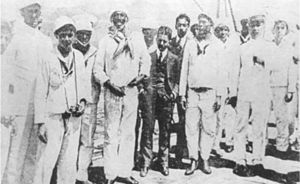Brazil, though a large, advancing nation in the early twentieth century and a leader among Latin American countries as part of the ABC Powers (Argentina, Brazil, & Chile), still stood as a culture suffering from racial division. While many French colonies had ended slavery with the Revolution in 1789, England had abolished it by act of Parliament in 1833, and the United States fought its civil war in 1861 partially over the matter, Brazil did not begin gradually ending slavery until 1871 with the passage of the Rio Branco Law (or "The Law of Free Birth") providing freedom for children newborn to slaves, the Saraiva-Cotegipe Law in 1885 freeing slaves over 60 years old, and finally total abolition in 1888 with the Lei Áurea shortly before the emperor was overthrown. While Brazil avoided much of the US's infamous institutionalization of race superiority with Jim Crow, there was still a significant social division of race among the wealthy whites and the blacks, paros (mixed race), and caboclos (mixed Euro-Indians), fed by intellectual “science” of the time.
While minorities were kept at a lower caste in general culture, the most obvious racism was felt in the military. In particular, the Brazilian navy was notorious for white commanders with minority crews held at their whim. Living conditions were poor aboard ship, but the navy was making leaps beyond other navies in comparable nations. In the early days of the Republic, the government focused on the army to quell internal problems, leaving only a handful of naval soldiers and less than 2,000 marines. As tiny as it was, the navy proved instrumental in the Revoltas da Armada of 1891 when President Marshal Deodoro da Fonseca attempted to dissolve Congress and continued to battle against President Marshal Floriano Peixoto who held onto office despite legal need of elections in the next few years. After the turn of the century, calls began for building up the navy and establishing Brazil as a significant power at sea. Other nations such as Britain, Germany, and the United States rushed into the naval arms race, and Brazil was quick to catch up with many new ships and two dreadnoughts, the Minas Gerais and São Paulo, both commissioned in 1910.
Economic downturn struck Brazil just after the completion of their dreadnoughts, causing the third proposed, Rio de Janeiro, to be shelved. The troubled times also turned into harder conditions aboard ship as well as on land with food and supplies cut back to save on expenses. General morale fell, which caused discipline to be sharpened, including the use of racial slurs and corporal punishment, specifically the lash. This aggravated two years of organization and protest against flogging, which involved "leather whips tipped with metal balls", and pushed the sailors into planned mutiny. The men aboard the Minas Gerais chose João Cândido Felisberto (“The Black Admiral”) as leader and watched furiously as a sailor was sentenced to 250 lashes, continuing even after he slipped into unconsciousness.
In the late hours of November 21, the men began their mutiny, killing officers and capturing British engineers as hostages. The revolt spread to the São Paulo as well as the Deodoro and the Bahia. Their demands began simply, but as Cândido saw that the Army was moving to protect the capital Rio de Janeiro and outnumber the coastal defenders who were sympathetic, he decided that the only way to survive was to make wider demands. The issue that tied the bulk of the oppressed together was the problem of race. Most of the sailors (as well as army and manual laborers) were black, many of them former slaves or their sons, forced into place by lack of other options. Cândido and his advisers (including several of the British) wrote up a new list of demands for rights despite race as well as taxes on the rich to support charities for the poor.
The “Letter to Brazil” (Letra a Brasil) was sent by written message, word of mouth, and even wireless, spreading through the country and spawning an upheaval in major cities and areas where minority populations outnumbered the whites. The army quickly came onto the side of the navy, which made the white elites unable to put down the revolt as they had many in the past. Britain began to step in, but when their hostages were cheerfully released home, Brazil was left to itself. Much of the government and the elites fled the country. The remainder invited Cândido ashore, and a new government was built following his manifesto.
Public education became mandatory as a subpoint on the Letter, and the new Brazilian Democratic Republic survived its depression to thrive as it contributed to the rebuilding of Europe after its neutrality in World War I. The Great Depression struck harder, and Getúlio Vargas swept elections with his nationalist rhetoric. He was invited by Adolph Hitler to join the new Axis, but Vargas decided to continue Brazilian elections and relations with the United States, leading to Brazil's participation in World War II. While economic issues arose after the war and rumors circulated about militaristic or even communist uprising in the 1960s, Brazil would ultimately continue to be a social model to the rest of the world.
–
In reality, the demands of the rebelling sailors were limited to more focused items such as the end of lashing, increased standards on ship, and amnesty for the mutiny, which they saw as a necessary action. The government quickly gave into Cândido's demands on fear of naval bombardment of the city, but they reneged on amnesty with a decree expelling government workers who were "undermining discipline.” Two thousand men were discharged afterward, and hundreds were killed or imprisoned, maintaining the power of the elite. However, the lash was never used again in the Brazilian Navy.

No comments:
Post a Comment